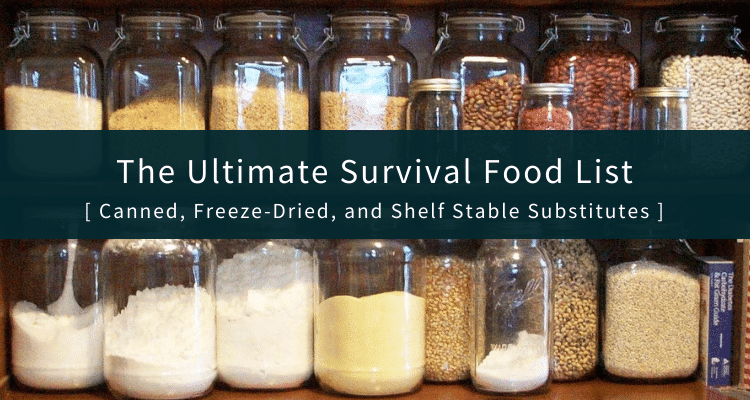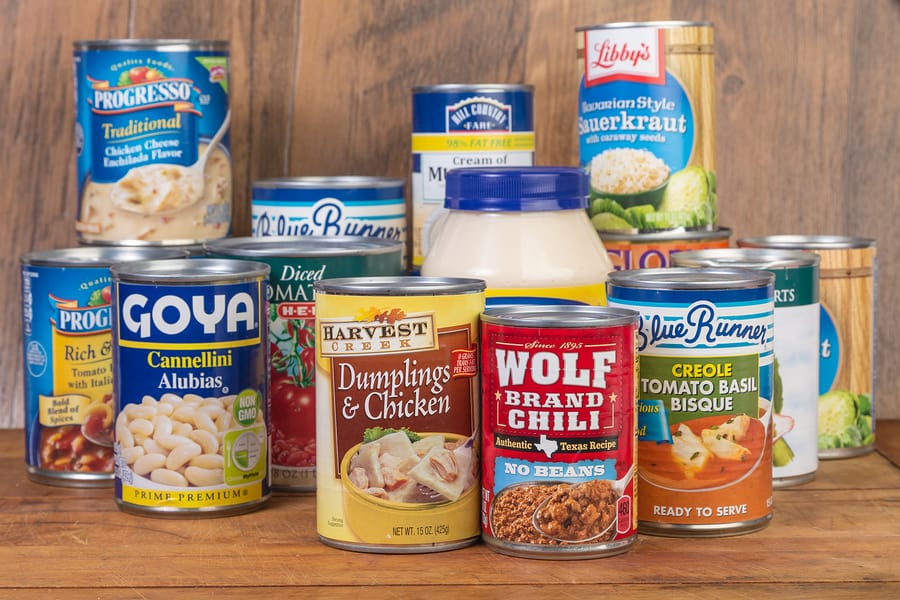How To Organize Your Survival Food Storage? Having enough food is a great way to ensure your survival in any situation. With how much of a supply we’re talking about here, there are many different ways to organize and store yours.
There are several good reasons to keep at least a month’s worth of food stored up. For one, it helps you stay well-fed while stores run out or stop supplying certain items.
Another is so that you don’t have to spend money by buying fresh supplies when you’ve got a lot already. A third is a self-confidence – knowing that you’ll be able to survive for some time gives you more strength.
This article will go into detail on various ways to organize and stockpile your nutrition supplies. There are no rules saying that only one method works, but some are better than others depending on what you want to do with your storage.
You can always try other methods as well, though! In fact, most people I know who eat well also store their supplies very carefully.
Prepper Pantry Storage
The best way to keep food fresh is by storing it properly. This means keeping it away from light, heat, humidity, and moisture. It also means making sure you don’t leave any foods out longer than necessary.

Rotating Your Food Storage
The best way to rotate food storage is by storing them at different temperatures. This will ensure that they don’t spoil too quickly. For example, if you store your dry goods in the freezer, then move them into the refrigerator, they should last longer than if you stored them all together in one spot.
Ways to Organize Your Emergency Food Storage
Emergency food storage is a great way to be prepared for any emergency situation. Whether you are preparing for a natural disaster or a power outage, having emergency food storage can help you get through the situation. Here are some tips on how to organize your emergency food storage:1. Store food that does not require refrigeration or freezing.
Canned goods, dried fruits and vegetables, and other non-perishable items are great for emergency food storage. Be sure to rotate your stock so that you are using the oldest cans first.
2. Store food in airtight containers.
Airtight containers will keep your food fresh and free from contaminants. Be sure to label the containers so you know what is inside.
3. Store food in a cool, dry place.
A cool, dry place is ideal for emergency food storage. Avoid storing food in direct sunlight or near heat sources.
4. Store food in a location that is easy to access.
You will want to be able to access your emergency food storage easily in an emergency situation. Choose a location that is close to an exit and easy to get to.
5. Have a plan for how you will use your emergency food storage.
You should have a plan for how you will use your emergency food storage in an emergency situation. This will help you be better prepared and know what to do in an emergency.
Organizing your emergency food storage is a great way to be prepared for any emergency situation. By following these tips, you can be sure that you will have the food you need to get through any emergency.
Long-Term Emergency Food Storage Organization Tips
Organizing your long-term emergency food storage can seem like a daunting task, but with a little planning and some helpful tips, it can be a breeze! Here are some tips to get you started:
1. Start with a plan. Decide what you need to store and for how long. This will help you determine the amount of food you need to purchase and how to best organize it.
2. Create a storage system that works for you. There are a variety of ways to store food long-term, so find the method that best fits your needs and space constraints.
3. Purchase high-quality food storage containers. This will help keep your food fresh and protected from pests and other contaminants.
4. Store your food in a cool, dark, and dry place. An ideal location would be a basement or other area that is not subject to extreme temperature fluctuations.
5. Inspect your food storage regularly. Check for signs of spoilage and pest activity, and rotate your food so that the oldest items are used first.
With a little planning and effort, you can easily create a long-term emergency food storage system that will be there for you when you need it!
Make a storage plan
As mentioned before, with all of these tips you will have enough food for several days! Now that we have covered some basic ways to organize your survival foods, it is time to make sure everything is stored properly and in the right place.
As you start organizing your supplies, remember that organization is more important than how much space you have. For example, instead of putting all of your dried goods in one box, put different types of dried fruits together and use color-coded boxes or bags to keep track of them easily. The same goes for canned items and other non-dried goods.
Also, do not forget about seasonality when storing your survival food. Certain foods such as carrots and tomatoes are susceptible to sprouting so they should be either protected from the air or placed in an oxygen-free container.
When storing individual foods, ensure that they can be accessed easily. This means labeling each item and keeping them organized by type (for example, pasta sauce, tea, etc.).
Research your storage supplies
One of the most important things you can do before storing your food is to learn how to organize and use your current supplies. For example, if you have glass jars for vegetables, why not invest in lids? If you have plastic bags for fruits and veggies, buy some new ones!
We suggest investing in either clear baggies with zipper closures or heavy-duty ziplock baggy containers. Both are very durable and can be used over and over again!
When organizing your survival foods, remember that organization does not need to look perfect every time you check it. It will only make finding what you need later much easier!
General tips: Use an index card (or paper clip) to keep each item organized by type of food (grains, meat, dried fruit, etc.). Use markers or writing tools to indicate where each one was stored and which stores they were transferred from.
Create storage containers
One of the most important things you can do in organizing your food stockpiles is to create adequate, durable containers for your food. There are many ways to organize and store your survival food supplies.
You don’t have to use exact methods that work for other people, but it is very helpful to know what works for you!
Many people keep their food in large bags or boxes with loose items. This can sometimes make it difficult to find a specific item because there isn’t a place for it.
Alternatively, people stack their foods next to each other in small, sealed plastic buckets. While this is better than having nothing at all, it may not be ideal for someone who wants to get into individualized packing.
There are two main reasons why organized, long-term food storage is needed. The first is to prevent hunger, which we already discussed. But the second reason has to do with preparedness.
In a crisis or disaster, there are usually limited resources available to help out others. These resources often include food, so keeping an ample supply away from the rest of the world makes sense. You never know when something will go bad and waste too much space.
With enough food for several months, you will have some wiggle room in helping others. Plus, once you have stored your own food, you stop consuming non-food goods, reducing potential exposure.
Fill your storage containers

One of the biggest mistakes that individuals make when organizing their survival food is filling their containers too full. This can be done in two ways:
Filling up the top of the container where there’s no space for a lid to fit or pull out, thus preventing you from storing one at a time
Overfilling the bottom of the container, which does not have a good shelf-like structure
Both of these are very common errors!
If you find yourself with no room left in your storage area, try looking through your home/workplace supplies to see if anything fits into another slot better. Also, invest in lidded plastic bags so you do not need to purchase extra coverings for your food.
Organizing your survival food should be planned ahead of time and organized according to what item it belongs under.
Store your food
One of the biggest mistakes people make when organizing their survival foods is having too many products in there. Having too much food can be disastrous if you have an emergency situation or need to prepare on the go.
Too much junk takes up valuable space, and it’s easy to forget what items you already have stored away!
If you find yourself with no storage facilities, try grouping similar types of food together. For example, if you don’t have enough bowls, group snacks that all fit into one container.
You should also consider buying some cheap plastic bins at a garage sale or second-hand store. These would work great for storing individual ingredients like dried fruits and vegetables.
Lastly, keep an eye out for free things you could use to create more storage. A friend’s mother always had a basket she never used, so my family got her baggie pouch bags from that. They are very durable and tight fitting, which is good for keeping food separate but not letting any get mixed up.
Cook your food
If you are having trouble organizing your survival food, then start by cooking your food! This is one of the most important things you can do in preparation for any kind of disaster.
By this I mean, if you have wheat or rice that you have been keeping in a bag at home, go shopping and get some bread or cook some pasta or rice. You will not be able to survive without it.
So, make sure to always have enough for at least a week’s worth of meals.
Another good way to organize your survival food storage is to keep a notebook next to each item with the recipe for that food. This helps you refer back to what you already have and makes re-organizing easier later on.
You also should know how to prepare most of these foods, so if you run out, you aren’t totally lost.
Eat your food
After you have gathered all of your supplies, it is time to actually prepare your food! The first step in organizing your survival food storage is to start eating your stored foods.
This will help you use up some of the space that has been wasted by leaving the food at room temperature or refrigerated. In addition, spending time preparing the food can also re-energize you as well as help you taste the food more fully.
If you are hungry, then they were worth storing! Also, remember that many recipes require cooked ingredients so do not worry about wasting any food before you get started.
Dispose of your waste
A large part of what makes survival food go bad is actually ingesting it. If you are storing your foods in close proximity, they may taste good at first but eventually, they will poison you.
The most common way to dispose of leftover food is by boiling or microwaving it and then mixing it with water. This process removes any chemical components that might remain and also destroys some nutritional value.
If there’s no liquid left, these chemicals can seep into the soil which could potentially harm surrounding plants.
